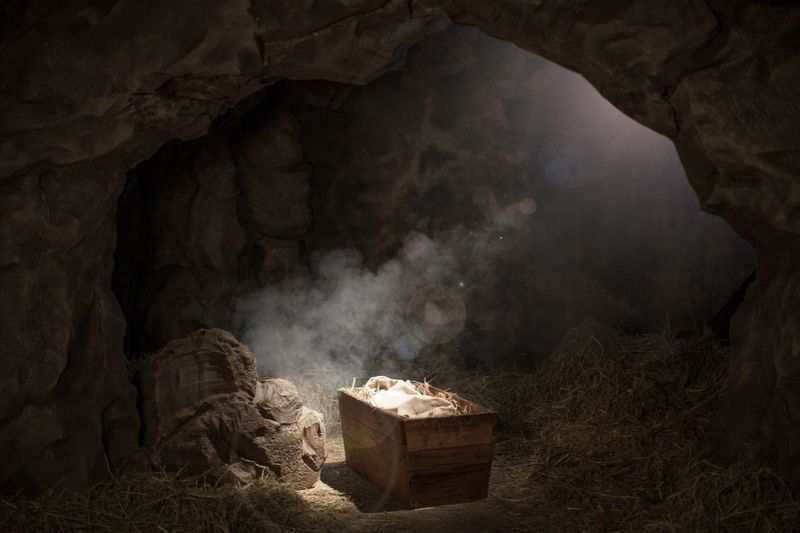Hey everyone, before jumping into today’s blog post, I wanted to share a quick note. I’ve been all but inconsistent since becoming a writer for the Misfits Theology Club. Especially so for the past few months. On August 10, 2019, we welcomed the newest addition to our family into this world: Cohen Scott. My wife went in for a regular checkup at 36 weeks pregnant, which led to her being kept in the hospital for a couple of days for “observation,” which led to us unexpectedly having our son a few weeks early. Even though he was technically a premie, he clocked in at 8 pounds 12 ounces, almost a full pound heavier than our full-term daughter. He’s done nothing but grow ever since, and our three-month-old is now in 9-12 month clothing.
It’s been an amazing journey, but it hasn’t necessarily been easy. Cohen has had a few issues over the past few months with his kidneys. Nothing life-threatening and nothing we weren’t expecting, since the doctors were able to notice the issues beforehand on my wife’s ultrasounds.
All this to say, writing hasn’t been at the top of my to-do list in a while. But now, with Advent suddenly and unexpectedly upon us, I wanted to jump on here and start a quick series on the book of Isaiah throughout this Advent season that I’ve called, Shalom Shalom.
Jesus in the Old Testament
How exactly does the Old Testament talk about Jesus? Many would say that passages in the Old Testament that seem to refer to Jesus were actually written about Jesus. As in, the authors sat down, had a vision about the historical person of Jesus of Nazareth, and wrote about him.
I’m very wary of using language to suggest that a passage in the Old Testament writers wrote about Jesus. I’ve got no problem saying the Old Testament writers point to Jesus in their writings, or that the Old Testament paves the way for Christianity.
So before we jump into an Advent exploration of the Book of Isaiah, it’s important to define how I’ll be approaching the Old Testament’s passages “about” Jesus.
Reading Backwards
“We learn to read the OT by reading backwards from the Gospels, and—at the same time—we learn to read the Gospels by reading forwards from the OT” -Richard Hays, Reading Backwards: Figural Christology and the Fourfold Gospel Witness
I’m kind of a political junkie. The fact that we’re in the thick of a democratic primary election makes me very happy. I spend my time researching poll numbers, rooting for my candidates, watching them rise or fall in the polls. I love watching debates and interviews. It’s my version of football. But here’s the thing: much like the actual sport of football, I don’t really get it. I don’t understand all the “plans” and “policies” proposed and debated by the candidates. Even though I love watching the debates, most of what they say goes in one ear and out the other.
But after a debate, the next day, I always listen to the NPR Politics Podcast to get me caught up. They’ll go over all the most important parts of the debate and explain it in a way that I can understand. After listening to that podcast, I can return to clips of the debate and actually understand what some of the candidates were saying.
Now, here’s where this ties into what we’re talking about, sort of. Okay, it’s not the perfect analogy, but hear me out. If I didn’t watch the debate, I wouldn’t really get a whole lot out of the podcast. And if I didn’t listen to the podcast, I wouldn’t really understand what was happening in the debate. This, I believe, is how the Old Testament and the New Testament work together. You can’t really have one without the other.
Figural Interpretation
Recorded in the Old Testament, we have the story of God’s people, Israel. It’s a beautiful story, a sad story, a frustrating story, a hopeful story. It’s so much all rolled into one.
Recorded in the New Testament, we have the story of God’s people, the Church. It’s the story of Jesus, who in many ways reenacted the story of Israel and brought it to its long-awaited climax.
If we approach the story of Jesus and the church with no understanding of Israel’s story, there are so many levels of depth to these scriptures that we miss out on.
At the same time, if we approach the story of Israel with no knowledge about how Jesus brought that story to fulfillment, we miss what God was doing through Israel the whole time.
The writers of the New Testament definitely picked up on this. By watching the life of Jesus through a very particular first-century Hellenistic second-temple Jewish lens, they came to a unique understanding. They knew the story and scriptures of Isreal, they saw first-hand the events in Jesus’ ministry, and they were able to say, “Oh, this is that!”
Oh, John the Baptist coming along and preparing the way for Jesus’ ministry? Yeah, this is the voice in the wilderness calling for the highways to be leveled out for God’s arrival. This is that.
You know that story of Jesus going out into the wilderness for forty day? Being tempted? Yeah, that’s the people of Israel wandering in the wilderness for forty years. This is that.
Jesus riding a donkey into the city of Jerusalem and hailed as King just before his crucifixion and resurrection? That’s gotta be this kingly figure Zechariah describes. This is that.
These scriptures, which the early Christians had been reading and digesting for their whole lives, were suddenly injected with a whole new dimension of truth and meaning. That doesn’t mean the scriptures didn’t have truth and meaning in and of themselves. But something about the story of Jesus completed those earlier stories. This is that.
This concept of reading backwards, gaining new insight about the Hebrew Bible by reading it in light of Jesus, is called “figural interpretation.” It means the Old Testament writers weren’t intentionally writing about Jesus of Nazareth. However, because of Jesus’ fulfillment of Israel’s story, their ancient writings suddenly have a whole new realm of meaning.
Where does the Holy Spirit Play Into This?
Some might argue that I’ve left no room for the Holy Spirit, and that the Bible was written only by human beings who didn’t know anything about the bigger picture of God’s plan.
I mean, you’re not completely wrong. When read individually, each author of scripture really didn’t know much about God’s overarching plan, although they all had their own glimpses and snapshots. But when read together, as a whole, we see what God was doing through Israel the whole time. We see what God was doing in the Church. Maybe we start to see what God has been doing throughout human history, and what he’s doing today. Therein lies the Holy Spirit.
I do believe the Holy Spirit inspired the writers of scripture to write, in the same way the Holy Spirit inspires writers today to write, in the same way the Holy Spirit inspires preachers to preach, teachers to teach, and friends to encourage and love one another.
I also believe the Holy Spirit inspired communities of believers throughout human history to gather, compile, redact, and canonize scripture. And yes, this includes the church’s habit of reading backwards. I don’t think the early Christians just randomly stumbled around the Old Testament and made connections to Jesus on a whim, twisting words and making it fit their own religious ideologies. When these followers of Christ recognized that “this is that,” it came out of a lifetime of prayer, study, meditation. It came out of a commitment to the Holy Spirit and to the community of believers.
So no, I don’t take the Holy Sprit’s role in the church or in scripture lightly.
On to Isaiah
That brings us to Isaiah, where I want to spend some time this Advent season. How does prophecy work in the book of Isaiah? Where is Jesus?
Well, despite what I’ve just told you about the concept of reading backwards in the early church, I think there are instances in Isaiah, little snapshots, that actually do look forward to the coming of Jesus. I don’t see as many instances as others may wish to find. But I do see some.
I also see many instances in which the New Testament writers read the text of Isaiah backwards, allowing their knowledge of the risen Christ to inform their understanding of Isaiah’s writings.
This Advent season, we’ll take a look at both types of prophetic interpretation in an effort to see what Isaiah’s prophecies can teach us about Advent, or the Coming of our King. Through the lens of Isaiah, how can we celebrate the birth of Christ while reflecting and preparing for his return?




